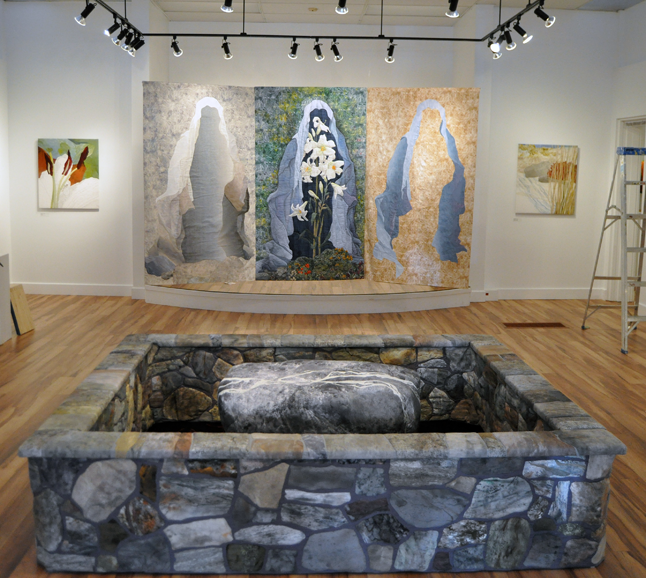
By Leslie Savage
The textile craft show now on at the Revelstoke Visual Arts Centre is stunning. It’s great to see this celebration of textile work: the quilted and felted pieces show what riches can accrue from unconventional materials.
The centerpiece of the show (B. Reid’s Homage to a Rock) takes one’s breath away. It’s a large fabric stone, surrounded by fabric stone walls, and set in front of a tryptich of three quilted panels. Together, these textile pieces constitute one of the most stunning pieces of Christian art I’ve seen in any contemporary setting for years.
This is a controversial statement. I repeated it to others at the show and they denied the religious connotation, sometimes emphatically.
Here’s what you see: a large fabric rock, stuffed, with a dyed and quilted exterior, about 4’ X 3” X 2.5’; a rough rock shape, but smooth too, so that you long to touch it, a tendency prohibited by the many signs on the (also) fabric stone wall surrounding the stone, saying Do Not Touch. Unfriendly but necessary, as the whole thing begs to be not just touched but hugged, held close, caressed. Immaculate craftsmanship; it is beautiful. And intimidating.
For this is the stone, surely, that was rolled in front of the tomb of Jesus.
An interpretation—and friends assured me this is a purely personal interpretation—enhanced by the tryptich behind it: History of a Lily, which, depicting in the center panel a lily inside what are clearly the robes of the Madonna—that lovely blue, the Easter Lily—and on each side of the lovely quilted lilies, Madonna’s empty robes—blue on one panel, taupe on the other, with emptiness inside the robes. In the left hand panel, the grey empty interior suggests as strongly as anything could, with that stone in front, the empty tomb of Jesus after the resurrection.
So: did the artist intend a Christian symbol of death and resurrection, or is the rather opaque artist statement accompanying the piece, about the history of lilies, and about motherhood and nature, really reflective of what inspired this piece? Perhaps the Christian allusion is subconscious?
The problem is one that besets this whole show: a lack of information. For me—and I am not a very convinced Christian but am culturally wholly cognizant of biblical stories whose meaning I have tried to ascertain for years—this is a message of Christian iconography: whatever the meaning of the Easter story, with the stone being rolled away from Jesus’s tomb by the time Mary comes on Easter Sunday to visit her son’s place of burial, this installation of fabric sculpture and panels raises many of the powerful questions that have puzzled historians for centuries: where are the contents of the tomb? What is the meaning of the emptiness? Where is the body of Jesus? What do we make of Mary’s love for her unusual son? Do we accept the scriptures and believe that God has taken his son up to the heavens? Or did the wretched Romans steal the body, fearing the martyrdom that later became the reality of the entire Christian faith?
Or is it all, after all, just about a lily?
To me, such a suggestion is typical of a secularist world bent on denying the rich symbolism of the Easter story, a story inherited from a pagan world who celebrated the end of winter as ritual death, and welcomed the growing season with rituals of rebirth, regeneration, fecundity and the mystery of connection between the sacred and the natural worlds. The haunting emptiness of the left hand panel, with its ghostly grey nothingness inhabiting Mary’s blanched robes, represents the empty tomb, the dead chaff in the wintered fields, the needed frozen soil that soon will warm to the spring sun. It represents the hollow nothingness of a life without a sense of the sacred, and leads, as we read from left to right, to the lushness of the lily’s growth, the nurtured plantings, the lives of those who live in faith—any faith—for the future, for growth, for their children’s lives, for new beginnings.
We don’t know about Beverley Reid’s inspiration, nor about how Richard Reid came to paint the lovely evanescent watercolours that grace the other rooms of the gallery. A significant gap is the absence of information about the artists and their work. I neglected to write down, and cannot find, the names of the other textile artists who contributed so emphatically to this show with feltings, quilts, knitted wall art, and gorgeous multimedia compilations, and my apologies to each of them.
How astonishing it is that such a brilliant exhibition lacks information about a hugely refreshing direction in the textile craft, and about a watercolourist who is clearly accomplished and produces such lovely ethereal works of art.



